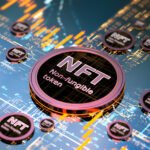In an era where financial sovereignty and blockchain technology intersect, DeFi lending has emerged as a pivotal innovation, redefining the essence of borrowing and lending. This cutting-edge approach not only democratizes finance by removing intermediaries but also ensures transparency and accessibility. The significance of DeFi lending cannot be overstated; it offers a seamless integration of cryptocurrency with financial services, presenting an alternative to traditional financial systems that is both efficient and inclusive.
This comprehensive guide delves into the crux of DeFi lending, comparing it with traditional lending mechanisms to underscore its unique advantages and challenges. Key topics include the emergence of DeFi in financial services, the operational mechanisms of DeFi lending, essential features of DeFi lending platforms, and the inherent risks involved. Additionally, the article explores popular DeFi lending platforms and looks ahead to the future of DeFi lending, providing readers with a thorough understanding of how to navigate the opportunities in this rapidly evolving sector.
The Emergence of DeFi in Financial Services
Understanding Decentralized Finance
Decentralized Finance, or DeFi, represents a shift towards a financial ecosystem that operates independently of traditional financial intermediaries like banks and brokers. By leveraging blockchain technology, DeFi enables peer-to-peer financial transactions, providing a level of autonomy, transparency, and security previously unattainable in conventional financial systems. The core of DeFi is built on smart contracts, which are self-executing contracts with the terms of the agreement directly written into code. These smart contracts facilitate a wide range of financial activities, including lending, borrowing, and trading, without the need for a central authority.
Historical Growth of DeFi
The DeFi sector has witnessed exponential growth, driven by the increasing accessibility of cryptocurrencies and the allure of substantial rewards. Since its inception, the total value locked (TVL) in DeFi protocols has soared, indicating a robust and rapidly expanding market. This growth is attributed to the innovative use of decentralized applications (dApps) that cater to a variety of financial services. The majority of the DeFi ecosystem is built on the Ethereum blockchain, which supports a wide array of services such as Compound, Aave, and MakerDAO. The emergence of decentralized exchanges (DEXs) like Uniswap, which utilize automated market makers (AMMs) instead of traditional order books, exemplifies the innovative approaches within DeFi to facilitate trading and liquidity.
Impact on Traditional Finance
The rise of DeFi poses significant challenges to the traditional banking model by offering an alternative that is more accessible, transparent, and cost-effective. DeFi platforms eliminate the need for intermediaries, thereby reducing transaction costs and enhancing the speed of transactions. This disintermediation not only threatens the existing banking model but also promotes financial inclusion by providing services to those who are underserved or unbanked by traditional systems. Furthermore, the transparency and security offered by blockchain technology, coupled with the efficiency of smart contracts, make DeFi a formidable competitor to conventional financial services. As DeFi continues to grow, traditional financial institutions may experience a decline in demand for their services, prompting a shift towards more decentralized and innovative financial solutions.
In conclusion, the emergence of DeFi in financial services marks a pivotal moment in the evolution of finance, challenging traditional paradigms and fostering a more inclusive, efficient, and secure financial ecosystem.
How DeFi Lending Works
Concept of Decentralized Lending
Decentralized finance lending, commonly referred to as DeFi lending, operates through peer-to-peer decentralized applications (DApps), allowing crypto holders to lend their assets and earn income, akin to the traditional lending services offered by banks but without intermediaries. Unlike conventional lending that relies on credit scores and extensive paperwork, DeFi lending utilizes smart contracts to automate lending agreements, making it more accessible and efficient for users globally. The essence of DeFi lending lies in its trustless nature, enabling users to lock their crypto assets on a DeFi lending platform without the need for intermediaries, thereby directly borrowing from the decentralized platform.
Role of Smart Contracts
Smart contracts, self-executing contracts with terms directly written into code, are central to DeFi lending. These contracts automate the borrowing and lending process, ensuring transparency and trust. By operating on blockchain technology, smart contracts facilitate a secure and transparent lending process without intermediaries, allowing borrowers to access loans faster and lenders to earn interest on their deposits. Smart contracts are designed to be interoperable, meaning they can interact seamlessly with other contracts, allowing for the creation of complex financial instruments and protocols. They often rely on oracles to fetch real-world data, such as asset prices or interest rates, enabling decisions based on real-time market conditions.
Process from Lender to Borrower
- Lenders Deposit Funds: Lenders deposit their cryptocurrency into a lending pool, making it available for borrowers. This process is akin to depositing money into a savings account, where lenders earn interest on their deposits.
- Borrowers Provide Collateral: Borrowers must provide collateral in cryptocurrencies, which are locked in a smart contract. This collateral secures the loan, mitigating the risk for lenders.
- Loan Terms and Interest Rates: The loan terms and interest rates are determined by the supply and demand dynamics within the DeFi platform, offering a decentralized and inclusive financial system.
- Use of Lending Pools: Users (lenders) deposit their cryptocurrency into a lending pool, which is then used to provide loans to other users (borrowers). This pool ensures quick distribution among borrowers through smart contracts.
- Collateralization Ratios: DeFi lending platforms implement collateralization ratios to determine the minimum amount of collateral required to borrow assets. For instance, a 150% collateralization ratio means a borrower must provide collateral worth 1.5 times the borrowed amount.
DeFi lending platforms, such as Compound, Aave, and MakerDAO, have revolutionized the traditional lending process by leveraging blockchain technology and smart contracts, operating on a peer-to-contract lending model and eliminating the need for traditional intermediaries like banks. This innovative approach has transformed the way lending works, making it more accessible, efficient, and transparent for users worldwide.

DeFi Lending vs. Traditional Lending
Differences in Process
DeFi lending operates on blockchain technology, enabling transactions without intermediaries, thus streamlining the process significantly compared to traditional lending. Traditional finance relies heavily on manual methods and third-party management, making it less efficient. In contrast, DeFi uses smart contracts to automate and secure transactions, offering a faster and more transparent lending experience. This automation in DeFi not only reduces the time taken for transactions but also minimizes the potential for human error.
Benefits Over Traditional Systems
One of the most significant advantages of DeFi over traditional systems is its ability to provide financial services to the unbanked population. An estimated 1.7 billion adults globally do not have access to a bank account, and DeFi can offer them services like savings and credit, which are crucial for financial security and economic opportunities. Moreover, DeFi eliminates the fees that banks and other financial institutions charge, further democratizing access to financial services. The peer-to-peer nature of DeFi platforms like Compound and Aave allows users to experience enhanced control over their transactions, fostering a sense of financial empowerment.
Challenges and Overcoming Barriers
Despite its benefits, DeFi faces challenges such as the risk of smart contract vulnerabilities, which can lead to hacking incidents and fund losses. Additionally, the fluctuating nature of interest rates in DeFi can pose a risk to users if not monitored closely. To overcome these barriers, it is essential for DeFi platforms to focus on improving the security of smart contracts and providing users with tools to manage the risks associated with variable interest rates effectively. Moreover, educating users about the workings of DeFi and its potential risks is crucial for its wider adoption and sustainability.
Also Read: Mastering DeFi Borrowing: Your Ultimate Guide to Crypto Loans in 2025
Key Features of DeFi Lending Platforms
DeFi lending platforms have revolutionized the way individuals and entities can access and provide loans, leveraging blockchain technology to offer a range of innovative features. Among these, collateralization and interest rates, flash loans, and governance tokens with community involvement stand out as key components that distinguish DeFi lending from traditional financial systems.
Collateralization and Interest Rates
One of the foundational aspects of DeFi lending platforms is the mechanism of collateralization. Borrowers are required to provide collateral in cryptocurrencies, typically exceeding the loan value, to mitigate the risk of default due to market volatility. A common standard is a 150% collateralization ratio, meaning if one wishes to borrow assets, they must lock in collateral worth 1.5 times the loan amount. This system ensures lenders are protected against potential losses, making DeFi lending attractive despite its higher perceived risk compared to traditional loans.
Interest rates in DeFi lending are dynamic, adjusting based on the demand for loans and the available liquidity in lending pools. This flexibility allows lenders to earn competitive yields on their deposits, often surpassing those offered by traditional banks. The interest paid by borrowers contributes to the lending yield, directly benefiting liquidity providers who supply the platforms with assets.
Flash Loans
Flash loans represent a unique and innovative feature exclusive to DeFi platforms. These are uncollateralized loans that must be borrowed and repaid within the same transaction block. Flash loans are primarily used for arbitrage, collateral swaps, and other trading strategies that can be executed swiftly. Despite their utility, flash loans have been associated with both positive innovations in trading and negative exploits due to their role in enabling attacks on vulnerable protocols. However, they underscore the flexibility and innovative potential of DeFi lending.
Governance Tokens and Community Involvement
Governance tokens are a pivotal feature of many DeFi lending platforms, offering holders voting rights on key decisions such as interest rates, collateral types, and protocol upgrades. This empowers users to shape the platform’s development and policies, fostering a decentralized and community-driven approach to financial services 283436.
These tokens not only incentivize participation but also align the interests of users with the long-term success and evolution of the platform. Projects like Compound, Uniswap, and MakerDAO have leveraged governance tokens to encourage user engagement and contribute to the platforms’ growth and adaptability 36.
DeFi lending platforms, with their innovative features of collateralization and dynamic interest rates, flash loans, and governance tokens, offer a glimpse into the future of finance. They provide a decentralized, transparent, and flexible alternative to traditional lending, empowering users to participate actively in the financial ecosystem.
Also Read: Unlocking the Power of Stablecoins: The Future of Cross-Border Payments
Understanding Risks in DeFi Lending
Smart Contract Vulnerabilities
Smart contracts are the backbone of DeFi applications, automating transactions and fostering trust among users. However, these contracts can contain bugs or vulnerabilities that malicious actors may exploit, posing a significant risk to users’ funds. To mitigate this risk, it’s crucial to use audited smart contracts and avoid those that are untested or unaudited. Additionally, ensuring the legitimacy of the DeFi platform is vital, as some smart contracts could be developed with malicious intent. Reputable third-party auditing firms play a key role in reviewing and auditing smart contracts, identifying vulnerabilities that can be addressed before deployment. Continuous updates based on audit findings are essential to keep smart contracts secure.
Market Volatility
The DeFi market is characterized by high volatility, with asset prices subject to rapid changes. This volatility can lead to significant losses for investors, although it also presents opportunities for substantial gains. Many DeFi platforms rely on cryptocurrencies like Ethereum, whose price fluctuations can impact the DeFi ecosystem. To manage market risk, DeFi participants may use trading tools such as limit orders and stop loss orders, or employ trading bots for more complex strategies. Despite these tools, the unpredictable nature of the market remains a challenge.
Regulatory Uncertainty
DeFi operates outside traditional regulatory frameworks, leading to legal uncertainties and regulatory risks. Regulations around DeFi vary significantly by region and are subject to rapid changes. In the U.S., DeFi regulation primarily occurs through legal actions by the Securities and Exchange Commission (SEC), without a clear regulatory framework from Congress. Europe has implemented clearer regulations, while regulation in Asia varies widely, from a near-total ban in China to a welcoming approach in Japan and Singapore. Staying up to date on regulatory developments is crucial for navigating the DeFi landscape.
Interest Rate Fluctuations and Liquidation Risks
Interest rates in DeFi lending are variable and can change quickly, based on the lending-borrowing demand within each money market. Without close monitoring, interest rates could unexpectedly increase, leading to the liquidation of assets. The risk of liquidation is compounded by the requirement for users to over-collateralize loans, often by more than 150%. To avoid liquidation, some platforms offer smart contract automation to automatically replenish collateral as its value decreases.
Security Concerns and Solutions
Despite the benefits of blockchain technology and smart contracts, such as reduced transaction fees and increased transparency, the open-source nature of DeFi exposes it to hacking risks. While centralized finance (CeFi) applications cannot provide insurance against security breaches, DeFi projects are working to develop offerings that enhance safety, security, and reliability. For example, the DeFi Pulse Index (DPI) allows users to build a portfolio of DeFi tokens without the need to monitor multiple decentralized exchanges (DEXs), offering a safer path into the industry.
Addressing Fraud and Market Manipulation
DeFi markets are susceptible to market manipulation, pump-and-dump schemes, and fraudulent projects. Decentralized oracles and data feeds provide accurate and tamper-proof price information, reducing the risk of price manipulation. Governance tokens and decentralized autonomous organizations (DAOs) empower the community to take action against malicious actors. Educational campaigns raise awareness about common scams and risks, equipping users with the knowledge to protect themselves.
Popular DeFi Lending Platforms
Overview of Top Platforms
DeFi lending platforms have significantly altered the landscape of financial services by providing an avenue for borderless and permissionless transactions. These platforms facilitate lending and borrowing activities through decentralized applications (DApps) that operate on blockchain networks using smart contracts. This setup not only enhances transparency but also automates the entire process, making it more efficient and accessible to users worldwide.
For instance, Aave and Compound are notable for their substantial impact on the DeFi lending space. Aave introduces uncollateralized flash loans and a variety of interest rate models, while Compound offers an algorithmic interest rate model that dynamically adjusts based on market demand. Both platforms support a wide range of cryptocurrencies, contributing to their widespread adoption and high total value locked (TVL), which signifies user trust and platform stability.
Unique Features and Offerings
DeFi lending platforms are distinguished by several unique features that enhance user experience and financial flexibility. For example, Aave’s flash loans allow for borrowing without collateral, provided the loan is returned within one transaction block. This feature is particularly useful for users engaging in arbitrage or other quick trading strategies.
Moreover, platforms like MakerDAO and Compound utilize governance tokens, which empower users to participate in decision-making processes related to platform updates and interest rate adjustments. This decentralized governance model not only promotes transparency but also ensures that the platforms are continuously evolving to meet user needs.
Additionally, some platforms offer innovative solutions like crypto and real-world asset (RWA) yield vaults, which enable users to diversify their portfolios and earn returns on a wider range of assets. These offerings highlight the platforms’ commitment to providing flexible and comprehensive financial services.
Comparative Analysis
When comparing various DeFi lending platforms, it’s essential to consider factors such as security measures, supported assets, user interface, and interest rates. Platforms like Aave, Compound, and MakerDAO have set high standards with their deep liquidity pools, user-friendly interfaces, and robust security protocols, which include regular smart contract audits and updates.
For instance, Compound’s user-friendly interface and automated interest rate model make it an attractive option for both beginners and experienced users. In contrast, Aave offers a slightly more complex range of features that cater to advanced users looking for flexibility in interest rates and loan types.
Security is another critical aspect, with top platforms implementing advanced measures to mitigate risks associated with hacking and other vulnerabilities. Regular updates and audits are crucial for maintaining trust and ensuring the safety of user funds.
By leveraging blockchain technology, these platforms provide a secure, transparent, and efficient method for users to lend and borrow digital assets without the need for traditional financial intermediaries. This not only reduces costs but also opens up financial services to a broader audience, including those who are underserved by conventional banking systems.
The Future of DeFi Lending
Upcoming Trends
The DeFi lending sector is poised for significant transformation, with several emerging trends set to redefine the landscape. The rise of decentralized exchanges (DEXs) and the integration of non-fungible tokens (NFTs) into DeFi are notable trends. DEXs facilitate cryptocurrency trades without central authority, enhancing the decentralized nature of financial services. Meanwhile, NFTs offer new ways to collateralize assets, broadening the scope of what can be leveraged in DeFi lending protocols. Furthermore, the advent of yield farming, where users earn rewards for providing liquidity, exemplifies the innovative mechanisms for generating returns in DeFi, surpassing traditional financial instruments in terms of yield potential.
Technological Advancements
Technological advancements are at the core of DeFi’s evolution, with Distributed Ledger Technology (DLT) and blockchain playing pivotal roles. DLT enables the recording and sharing of data across multiple data stores, ensuring transactions are recorded in an immutable manner. This technology underpins ecosystem financing, allowing for the storage of financial transactions in multiple places at once. Cross-chain technology is another critical advancement, facilitating blockchain interoperability and enabling different protocols to share data and value seamlessly. These technologies are fundamental to DeFi’s promise of providing decentralized, transparent, and efficient financial services.
Smart contracts and AI integration represent another layer of technological innovation in DeFi lending. Smart contracts automate transactions and eliminate intermediaries, while AI-powered solutions leverage machine learning to optimize processes and decision-making. AI-driven credit scoring models and robo-advisors are examples of how technology is used to assess credit risk more accurately and optimize asset management, respectively. These advancements contribute to making DeFi lending more accessible, efficient, and tailored to individual needs.
Predictions on Market Growth
The DeFi lending market is expected to witness exponential growth in the coming years. Projections indicate that the global DeFi market could reach a value of USD 446.43 billion by 2031, growing at a compound annual growth rate (CAGR) of 46.80% over the forecast period. This growth is driven by DeFi’s scalability, enhanced functionality, and security features, which are attracting institutional investors seeking reliable investment opportunities. Furthermore, the DeFi market is projected to grow from $9.4 billion in 2021 to $70.3 billion in 2027, with a CAGR of 39.5% during the forecast period. This growth is fueled by increased digitization, high investment activity in the DeFi sector, and the continued development of new use cases and applications.
The integration of traditional finance with DeFi is expected to play a significant role in this growth. By combining the innovation and efficiency of DeFi with the stability and security of traditional finance, a more robust and inclusive financial ecosystem can be created. This synergy has the potential to provide financial services to traditionally excluded populations, democratizing access to financial services and fostering financial inclusion.
In summary, the future of DeFi lending is marked by promising trends, technological advancements, and optimistic market growth predictions. As the sector continues to evolve, it holds the potential to reshape the financial landscape, offering more inclusive, efficient, and secure financial services.
Navigating Opportunities in DeFi Lending
Strategies for Engagement
DeFi lending platforms offer a revolutionary transformation in financial services by utilizing blockchain technology to facilitate peer-to-peer transactions without intermediaries. To effectively engage with these platforms, users and institutions can leverage cross-chain functionality to access a broader range of assets and enhance liquidity. Furthermore, incorporating advanced privacy and security measures, such as zero-knowledge proofs, can protect sensitive financial information and build trust among users. Engaging with DeFi also involves understanding the impact of AI and machine learning, which are increasingly used to optimize lending operations and risk assessments.
Identifying and Mitigating Risks
Navigating DeFi lending necessitates a keen awareness of various risks. Smart contract vulnerabilities can pose significant threats, hence regular audits and adopting best practices in smart contract development are crucial. Market volatility and liquidity issues should be managed by implementing robust risk management strategies, including diversifying collateral and setting up circuit breakers. Additionally, regulatory changes continue to shape the landscape, requiring continuous monitoring and adaptation to ensure compliance and protect user interests.
The Path Forward for Investors and Borrowers
For investors and borrowers, the path forward in DeFi lending involves several strategic approaches. Firstly, embracing decentralized identity solutions can streamline the lending process and enhance user privacy. Expanding collateral options beyond cryptocurrencies to include real-world assets can unlock new liquidity sources and provide more flexibility in lending. Investors should focus on platforms that offer transparency and user-friendly interfaces to monitor investments and manage risks effectively. Borrowers, on the other hand, can benefit from platforms that provide flexible terms and access to a variety of lending pools to optimize their borrowing strategies.
Conclusion
Through the exploration of various facets of DeFi lending—from its emergence and underlying mechanisms to the comparison with traditional lending, and the examination of its risks, platform features, and future outlook—it’s evident that DeFi lending represents a transformative shift in the financial services landscape. This guide has underscored the advantages of DeFi lending, such as increased accessibility, transparency, and the democratization of finance, while also addressing the challenges it faces, including security vulnerabilities and the need for regulatory clarity. The insights provided illuminate the significant impact DeFi lending has on offering an efficient, inclusive alternative to traditional financial systems, marking a pivotal moment in the evolution of finance.
Looking ahead, the future of DeFi lending appears promising, with emerging trends and technological advancements poised to further refine and expand its capabilities. The potential for exponential market growth, alongside the evolution of new use cases and the integration of DeFi lending into traditional finance, holds the promise of reshaping the global financial ecosystem. As the sector continues to mature, it will undoubtedly offer novel opportunities and challenges, driving forward the narrative of financial innovation and inclusion. The journey of DeFi lending is just beginning, and it will be fascinating to witness its unfolding impact on the world of finance.
FAQs
What are the ways to earn through DeFi lending?
DeFi lending can provide various opportunities for passive income generation. Some of the primary methods include:
- Providing liquidity to pools
- Staking cryptocurrencies
- Participating in yield farming
- Engaging in lending and borrowing activities
- Contributing to Automated Market Making (AMM) pools
- Creating and trading synthetic assets
- Farming governance tokens
- Earning token rewards and participating in airdrops.
Is it possible to obtain a loan via DeFi platforms?
Yes, obtaining a loan through DeFi is accessible to anyone using platforms such as Compound or Aave. Borrowers need to deposit collateral, typically in the form of another cryptocurrency, to secure a DeFi crypto loan.
How can a beginner start using DeFi?
For beginners looking to dive into DeFi, the process involves several key steps:
- Step 1: Set up a DeFi-compatible wallet.
- Step 2: Fund your wallet and purchase necessary tokens.
- Step 3: Understand and engage in DeFi investment activities like staking, lock-ups, lending, borrowing, farming, and mining.
- Step 4: Explore and evaluate various DeFi projects.
What are the benefits of DeFi lending?
DeFi lending offers significant advantages for both lenders and borrowers. It provides margin trading opportunities, allows long-term investors to lend their assets for higher interest returns, and enables users to access fiat currency credit. Additionally, borrowing rates on DeFi platforms are generally lower than those on traditional decentralized exchanges.









